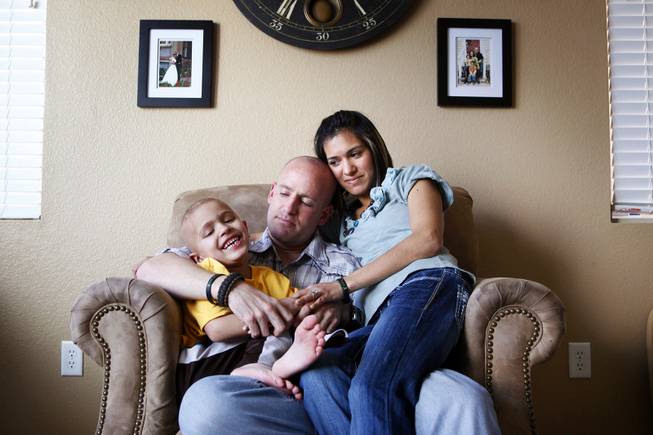
Jennica and Matthew LeBaron with their son Caleb, 6, inside their home in North Las Vegas on Friday, Feb. 17, 2012.
Monday, Feb. 20, 2012 | 2 a.m.
When 6-year-old Caleb LeBaron was diagnosed with a rare form of a highly aggressive cancer in December, doctors immediately swung into action.
Caleb’s chemotherapy treatment began the day after his diagnosis with Burkitt’s lymphoma — which came two weeks after his parents first noticed symptoms. Despite the shocking news that their son was seriously ill, Matthew and Jennica LeBaron were reassured when doctors told them that with proper drugs and treatment, the cancer has an 85 percent remission rate.
But Caleb’s recovery was threatened this past week when medical officials around the country sounded the alarm about a potential shortage of preservative-free methotrexate — a generic, injectable chemotherapy drug that is relied on by Caleb and thousands of other children around the country, many who have acute lymphoblastic leukemia, the most common form of childhood cancer.
“It was very scary. It’s this pit in your stomach,” said Jennica LeBaron. “(We thought) what are we going to do? His life depends on it.”
Fortunately, swift action by pharmaceutical companies and the U.S. Food and Drug Administration averted the shortage. But the scare still lingers with the LeBarons.
“(A shortage) hasn’t affected us yet, but it’s scary, because it still could,” Jennica LeBaron said. “We’re in this for at least nine months … there’s not time to delay treatment because (the cancer) progresses so fast.”
The incident also underscores a growing trend of drug shortages around the country.
Two local hospitals, University Medical Center and Sunrise Children’s Hospital, said they were unaffected by the methotrexate scare and had adequate supplies on hand to weather any temporary shortages.
But more than 250 different drugs, for both cancer treatment and other uses, will be in short supply at some point in 2012, said Dr. James Hoffman, the medication outcomes and safety officer at St. Jude Children’s Research Hospital in Tennessee.
“For many years, we’ve seen some level of shortages, especially in hospitals. But over the last couple of years it’s really increased,” he said.
Hoffman described the pharmaceutical manufacturing industry as complex and interconnected, where a small problem can ripple outward and have effects throughout the market.
The recent methotrexate shortage was sparked at least in part by the closure of several Ohio-based factories owned by one of the drug’s major manufacturers due to drug-quality concerns.
“Many of the products that go on short supply only have maybe one, two or three manufacturers. If you have one manufacturer go down, that’s a real problem because there’s not a lot of slack in the system to make that up,” Hoffman said.
That dip in production led to concerns of a shortage, but action by the FDA and other drug manufacturers has filled the gap for now.
Without quick action, the shortage could have threatened the chances of recovery for thousands of patients, Hoffman said.
“If we are forced because of a drug shortage to deviate from our standardized practices … that puts a new safety risk into the system we didn’t have before,” he said.
Predicting and preventing future drug shortage is challenging, Hoffman said, but increased communication between drug manufacturers, federal agencies and healthcare providers has been effective and led to the prevention of at least 200 drug shortages in 2011.
A new law mandating drug manufacturers to communicate potential shortages has been brought before Congress several times, Hoffman said, but has failed to pass so far.
“This is a real case where patients can contact Congress,” he said. “These bills, while they aren’t going to fix everything about drug shortages, are an excellent first step and the FDA has proven they can use this information in a positive way.”
The Associated Press contributed to this story.


Join the Discussion:
Check this out for a full explanation of our conversion to the LiveFyre commenting system and instructions on how to sign up for an account.
Full comments policy